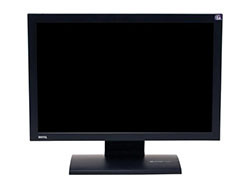Pre-AM2 Mid-Range Buyers' Guide, May 2006
by Jarred Walton on May 9, 2006 6:30 AM EST- Posted in
- Guides
Display Recommendations
We used about one fourth of the total budget on the motherboard and processor recommendations, and we're willing to use another fourth of the budget on a good quality display. I've said it in the past: I'm done with CRT recommendations. It's not that LCDs are perfect, but CRTs pretty much target the budget market exclusively these days, not mention their size disadvantage. We wish it was possible to get a 1920x1200 LCD with a 100 Hz refresh rate, for example, but unfortunately such a resolution is not part of the DVI spec.I also encourage people to overspend on displays if at all possible; a good display can easily outlast the rest of your system, and you're going to be staring at it every day that you use your computer. We've recommended 19 inch LCDs in the past for the midrange sector, but prices are at the point where we can now fit a 20 inch widescreen display into the $1500 midrange budget. Naturally, if you don't want to spend $325, you can skip out on the 20 inch widescreen displays, but we feel the extra $75 is money well spent.
 |
| Click to enlarge |
Display Recommendation: BenQ 20 inch 8ms Widescreen LCD FP202W
Price: $325 shipped (Retail)
BenQ's latest LCD offering has a great price, and it's a reasonable quality display as well. 16.7 million colors (no dithering), DVI and VGA connections, 8ms response times (gray-to-gray/GTG), and a native 1680x1050 resolution. You get all of that for a price of $325 - and Newegg even has a $40 mail-in rebate if you hurry. There's no pivot mode (does anyone actually use portrait mode with widescreen displays?), and a slightly more important negative point is that there's no height adjustment on the stand. The display also feels a bit flimsy, but we would still take it over a sturdier display that costs $100 more.
 |
| Click to enlarge |
Display Alternative: Acer 24 inch 6ms Widescreen LCD AL2416Wd
Price: $735 shipped (Retail)
This is the one alternative that we're explicitly listing. A 20 inch widescreen display is nice, but a 24 inch widescreen display is better! 6ms GTG response times, 16.7 million colors, and a native 1920x1200 resolution. It doesn't get much better than this, at least in the world of the LCDs. In order to keep the price down, Acer doesn't have as many options as some of the other 24 inch displays, but you probably won't miss most of the features. Integrated flash memory reader? Component inputs? The Dell 2405FPW has those, but it also costs more money - even if you can find it on sale. Subjectively, some people will prefer the look and features of the 2405FPW, but it's hard to argue with an extra couple hundred dollars in your pocket.
If you're looking for cheaper display options, check out the 19 inch standard aspect ratio LCDs. The Acer AL1951B ($257), BenQ FP93GX, and BenQ FP91G+ ($220) are some of our top picks, and all three have the requisite DVI connection. Of those, picking a "best" LCD is a matter of compromises. If you're after lower response times, the BenQ "2ms" FP93GX should deliver, though image quality may be compromised in the pursuit of response times on such panels.
For example, the Acer says it has 16.7 million colors while the BenQ displays only list 16.2 million colors with dithering. Dithering isn't the end of the world, but it can affect image quality, so if you do any form of image editing you might want a better display. Whether or not you can see the dithering depends on the individual, the display, as well as how the monitor is being used. Try looking at some color charts showing all 256 shades of red, green, and blue, and see if you can spot the transitions. Using those charts on several 8-bit LCDs, only the green clearly shows individual color transitions, and the 6-bit panel looked about the same.
| Display Alternatives | |
| BenQ 19 inch 2ms FP93GX | 260 |
| Acer 19 inch 6ms AL1951B | 257 |
| BenQ 19 inch 8ms FP91G+ | 210 |










56 Comments
View All Comments
Griswold - Tuesday, May 9, 2006 - link
Shouldnt always go for the bigger number at a similar price. There are more important numbers with PSUs than the absolute wattage.KorruptioN - Tuesday, May 9, 2006 - link
Even though it's only rated at 400W overall (yes, wattage is not the best indicator of overall output), it can do 30A on the +12V output alone (360W divided by 12V), which is a good amount for a non-SLI configuration. Even two 7600GTs wouldn't be enough to push this power supply past it's limits. I think it is a good all-around choice.JarredWalton - Tuesday, May 9, 2006 - link
I've got a system very similar to this, only with a 7800 GTX, an overclocked X2 3800+, and two 250GB hard drives... all running off a Thermaltake 410W PSU. Maximum power draw hits about 315W - and that's not even counting for PSU efficiency (i.e. that's measuring at the outlet).I mentioned several alternative PSUs that people can consider. Why do I like modular units? Sleeved cables, reduced cable clutter, and for an extra $15 I'm willing to go that route. Opinions vary, naturally - this guide is basically my opinion, after all.
IntelUser2000 - Tuesday, May 9, 2006 - link
Sure about that. Only 35%?? I think 35% will be the absolute minimum over Netburst in Netburst optimized apps.
peternelson - Tuesday, May 9, 2006 - link
Difficult to make comparisons of "same price" netburst cpu, because Intel roadmap will make FURTHER REDUCTIONS in price of 930,940,950 after Core Duo 2 launches through November.950 probably isn't going to compete with the new chips on total performance, but may not be that bad in bang for buck in comparison.
JarredWalton - Tuesday, May 9, 2006 - link
Rough estimate, and it could be more or less depending on benchmarks. Core Duo T2300 costs a bit more than Pentium D 930. Looking at *stock* performance, AutoGK encoding for example should be around 55 FPS for the 930, while the T2400 get 44 FPS. Even with a 25% boost in performance, the Core Duo 2 $210 CPU is probably going to about equal PD 930.The flipped side is that some benches (games especially) will be more than 35%. PD 920 at 2.8 GHz maxes out at 63 FPS in BF2, roughly. (Doesn't matter about resolution - 800x600 still gets ~63 FPS.) Gary got 83 FPS with T2400 at stock, and 112 at 2.8 GHz. If CD2 gives another 25%... we're looking at maybe 104 FPS for a 1.83 GHz Core Duo 2. Assuming such a chip costs $210, it's got a 65% performance advantage. :)
Anyway, I'll tweak the text slightly.